Energy-Efficient Smart Window Based on a Thermochromic Hydrogel with Adjustable Critical Response Temperature and High Solar Modulation Ability
Abstract
:1. Introduction
2. Results and Discussion
2.1. Fabrication of the HBPEC/PNIPAM Hydrogel
2.2. Tuning the LCST of HBPEC/PNIPAM Hydrogels by Adjusting the Butoxy DS of HBPEC
2.3. Optical Properties of the HBPEC/PNIPAM Smart Window
2.4. Mechanical Properties of the HBPEC/PNIPAM Hydrogel
2.5. Energy-Saving Performance of the HBPEC/PNIPAM Smart Window
3. Conclusions
4. Materials and Methods
4.1. Materials
4.2. Synthesis of 2-Hydroxy-3-butoxypropyl Hydroxyethyl Celluloses (HBPEC)
4.3. Fabrication of the HBPEC/PNIPAM Hydrogel
4.4. Fabrication of the Model House and Smart Window
4.5. Mechanical Characterization
4.6. Optical Characterization
4.7. Indoor Temperature Regulation Simulation Tests
Supplementary Materials
Author Contributions
Funding
Institutional Review Board Statement
Informed Consent Statement
Data Availability Statement
Conflicts of Interest
References
- Ma, D.; Chen, L.; Fan, F.; Wang, Q.; Duan, G.; Bi, L.; Mei, L.; Bi, K.; Chen, Y.; Duan, H. Solar light management enabled by dual-responsive smart window. ACS Appl. Mater. Interfaces 2022, 14, 56065–56073. [Google Scholar] [CrossRef]
- Niu, Y.; Zhou, Y.; Du, D.; Ouyang, X.; Yang, Z.; Lan, W.; Fan, F.; Zhao, S.; Liu, Y.; Chen, S.; et al. Energy saving and energy generation smart window with active control and antifreezing functions. Adv. Sci. 2022, 9, 2105184. [Google Scholar] [CrossRef] [PubMed]
- Chang, Q.; Shen, Z.; Guo, Z.; Xue, C.; Li, N.; Yang, J.; Hu, S. Hydroxypropylmethyl cellulose modified with carbon dots exhibits light-responsive and reversible optical switching. ACS Appl. Mater. Interfaces 2021, 13, 12375–12382. [Google Scholar] [CrossRef] [PubMed]
- Feng, Y.; Ma, W.; Li, H.; Yang, M.; Yu, Y.; Liu, S.; Zeng, X.; Huang, F.; Yang, Y.; Li, Z. Phase-changing polymer film for smart windows with highly adaptive solar modulation. ACS Appl. Mater. Interfaces 2023, 15, 5836–5844. [Google Scholar] [CrossRef] [PubMed]
- Hu, X.; Cheng, Y.; Wei, Z.; Zhan, Y.; Zhang, R.; Xia, H.; Jiang, X. Smart windows with adjustable electromagnetic interference shielding using hydrogel technology. Chem. Eng. J. 2024, 493, 152533. [Google Scholar] [CrossRef]
- Jiang, Q.; Chen, M.; Qin, Z.; Li, Y.; Li, J.; Zhang, H. Stable and thermochromic organohydrogels for thermostatically controlled display windows. Chem. Eng. J. 2024, 489, 151259. [Google Scholar] [CrossRef]
- Zhang, R.; Li, R.; Xu, P.; Zhong, W.; Zhang, Y.; Luo, Z.; Xiang, B. Thermochromic smart window utilizing passive radiative cooling for self-adaptive thermoregulation. Chem. Eng. J. 2023, 471, 144527. [Google Scholar] [CrossRef]
- Zhang, R.; Xiang, B.; Feng, M.; Xu, Y.; Xu, L.; Xia, L. Design of VO2-based photoactuators for smart windows. J. Mater. Sci. 2020, 55, 10689–10698. [Google Scholar] [CrossRef]
- Lin, G.; Chandrasekaran, P.; Lv, C.; Zhang, Q.; Tang, Y.; Han, L.; Yin, J. Self-similar hierarchical wrinkles as a potential multifunctional smart window with simultaneously tunable transparency, structural color, and droplet transport. ACS Appl. Mater. Interfaces 2017, 9, 26510–26517. [Google Scholar] [CrossRef]
- Singh, A.K.; Kiruthika, S.; Mondal, I.; Kulkarni, G.U. Fabrication of solar and electrically adjustable large area smart windows for indoor light and heat modulation. J. Mater. Chem. C 2017, 5, 5917–5922. [Google Scholar] [CrossRef]
- Xu, Z.; Wang, S.; Hu, X.Y.; Jiang, J.; Sun, X.; Wang, L. Sunlight-induced photo-thermochromic supramolecular nanocomposite hydrogel film for energy-saving smart window. Sol. RRL 2018, 2, 1800204. [Google Scholar] [CrossRef]
- Zhong, Y.; Wang, Y.; Zhou, Y.; He, Q.; Ge, S.; Liu, X.; Xu, R.; Feng, S. Fabrication of FTO/PNIPAm/FTO electrical-thermal dual-response smart window for solar radiation management in the full temperature range. ChemistrySelect 2021, 6, 5496–5503. [Google Scholar] [CrossRef]
- Zhou, Y.; Layani, M.; Wang, S.; Hu, P.; Ke, Y.; Magdassi, S.; Long, Y. Fully printed flexible smart hybrid hydrogels. Adv. Funct. Mater. 2018, 28, 1705365. [Google Scholar] [CrossRef]
- Liu, S.; Li, Y.; Wang, Y.; Du, Y.; Yu, K.M.; Yip, H.-L.; Jen, A.K.Y.; Huang, B.; Tso, C.Y. Mask-inspired moisture-transmitting and durable thermochromic perovskite smart windows. Nat. Commun. 2024, 15, 876. [Google Scholar] [CrossRef] [PubMed]
- Peng, H.; Yang, X.; Gu, Y.; Yang, Q.; Lan, T.; Chen, S.; Yan, B. Thermochromic smart windows with broad-range customizable responsive temperature via the hofmeister effect. J. Mater. Chem. A 2023, 11, 17848–17857. [Google Scholar] [CrossRef]
- Ariga, K. Nanoarchitectonics for advanced applications in energy, environment and biology: Method for everything in materials science. Beilstein J. Nanotechnol. 2023, 14, 738–740. [Google Scholar] [CrossRef] [PubMed]
- Ariga, K. Nanoarchitectonics: The method for everything in materials science. Bull. Chem. Soc. Jpn. 2024, 97, uoad001. [Google Scholar] [CrossRef]
- Ariga, K. Liquid–liquid and liquid–solid interfacial nanoarchitectonics. Molecules 2024, 29, 3168. [Google Scholar] [CrossRef]
- He, Q.; Wang, Y.; Zhou, Y.; He, M.; Xu, R.; Hu, S.; Wu, W.; Wang, R. PAM-PNIPAM/W-doped VO2 thermochromic hydrogel film with high solar modulation capability for smart windows deployment. Opt. Mater. 2019, 97, 109367. [Google Scholar] [CrossRef]
- Ali, F.; Khan, I.; Chen, J.; Akhtar, K.; Bakhsh, E.M.; Khan, S.B. Emerging fabrication strategies of hydrogels and its applications. Gels 2022, 8, 205. [Google Scholar] [CrossRef]
- Nasution, H.; Harahap, H.; Dalimunthe, N.F.; Ginting, M.H.S.; Jaafar, M.; Tan, O.O.H.; Aruan, H.K.; Herfananda, A.L. Hydrogel and effects of crosslinking agent on cellulose-based hydrogels: A review. Gels 2022, 8, 568. [Google Scholar] [CrossRef] [PubMed]
- Zhao, C.; Lv, Q.; Wu, W. Application and prospects of hydrogel additive manufacturing. Gels 2022, 8, 297. [Google Scholar] [CrossRef]
- Wang, K.; Zhang, L.; Jiang, X. Freezing-resistant poly(N-isopropylacrylamide)-based hydrogel for thermochromic smart window with solar and thermal radiation regulation. J. Colloid Interface Sci. 2023, 652, 663–672. [Google Scholar] [CrossRef] [PubMed]
- Zhang, H.; Liu, J.; Shi, F.; Li, T.; Zhang, H.; Yang, D.; Li, Y.; Tian, Z.; Zhou, N. A novel bidirectional fast self-responsive PVA-PNIPAM/LimCsnWO3 composite hydrogel for smart window applications. Chem. Eng. J. 2022, 431, 133353. [Google Scholar] [CrossRef]
- Wei, G.; Yang, D.; Zhang, T.; Yue, X.; Qiu, F. Thermal-responsive PNIPAm-acrylic/Ag NRs hybrid hydrogel with atmospheric window full-wavelength thermal management for smart windows. Sol. Energy Mater. Sol. Cells 2020, 206, 110336. [Google Scholar] [CrossRef]
- Chen, L.; Duan, G.; Zhang, C.; Cheng, P.; Wang, Z. 3D printed hydrogel for soft thermo-responsive smart window. Int. J. Extrem. Manuf. 2022, 4, 025302. [Google Scholar] [CrossRef]
- Wang, S.; Zhou, Y.; Jiang, T.; Yang, R.; Tan, G.; Long, Y. Thermochromic smart windows with highly regulated radiative cooling and solar transmission. Nano Energy 2021, 89, 106440. [Google Scholar] [CrossRef]
- Zhang, L.; Du, Y.; Xia, F.; Gao, Y. Two birds with one stone: A novel thermochromic cellulose hydrogel as electrolyte for fabricating electric-/thermal-dual-responsive smart windows. Chem. Eng. J. 2023, 455, 140849. [Google Scholar] [CrossRef]
- Zhang, L.; Xia, H.; Xia, F.; Du, Y.; Wu, Y.; Gao, Y. Energy-saving smart windows with HPC/PAA hybrid hydrogels as thermochromic materials. ACS Appl. Energy Mater. 2021, 4, 9783–9791. [Google Scholar] [CrossRef]
- Yang, Y.-S.; Zhou, Y.; Chiang, F.B.Y.; Long, Y. Tungsten doped VO2/microgels hybrid thermochromic material and its smart window application. RSC Adv. 2017, 7, 7758–7762. [Google Scholar] [CrossRef]
- Tian, Y.; Ju, B.; Zhang, S.; Hou, L. Thermoresponsive cellulose ether and its flocculation behavior for organic dye removal. Carbohydr. Polym. 2016, 136, 1209–1217. [Google Scholar] [CrossRef] [PubMed]
- Wang, K.; Chen, G.; Weng, S.; Hou, L.; Ye, D.; Jiang, X. Thermo-responsive poly(N-isopropylacrylamide)/hydroxypropylmethyl cellulose hydrogel with high luminous transmittance and solar modulation for smart windows. ACS Appl. Mater. Interfaces 2023, 15, 4385–4397. [Google Scholar] [CrossRef]
- Xu, G.; Xia, H.; Chen, P.; She, W.; Zhang, H.; Ma, J.; Ruan, Q.; Zhang, W.; Sun, Z. Thermochromic hydrogels with dynamic solar modulation and regulatable critical response temperature for energy-saving smart windows. Adv. Funct. Mater. 2021, 32, 2109597. [Google Scholar] [CrossRef]
- Yu, Z.; Yang, Y.; Shen, C.; Mao, L.; Cui, C.; Chen, Z.; Zhang, Y. Thermochromic hydrogels with an adjustable critical response temperature for temperature monitoring and smart windows. J. Mater. Chem. C 2023, 11, 583–592. [Google Scholar] [CrossRef]
- Xie, L.; Wang, X.; Zou, X.; Bai, Z.; Liang, S.; Wei, C.; Zha, S.; Zheng, M.; Zhou, Y.; Yue, O.; et al. Engineering self-adaptive multi-response thermochromic hydrogel for energy-saving smart windows and wearable temperature-sensing. Small 2023, 19, 2304321. [Google Scholar] [CrossRef] [PubMed]
- Aburas, M.; Soebarto, V.; Williamson, T.; Liang, R.Q.; Ebendorff-Heidepriem, H.; Wu, Y.P. Thermochromic smart window technologies for building application: A review. Appl. Energy 2019, 255, 113522. [Google Scholar] [CrossRef]
- Shen, W.B.; Li, G.Q. Recent progress in liquid crystal-based smart windows: Materials, structures, and design. Laser Photonics Rev. 2023, 17, 2200207. [Google Scholar] [CrossRef]
- Zhou, Y.; Dong, X.X.; Mi, Y.Y.; Fan, F.; Xu, Q.; Zhao, H.; Wang, S.C.; Long, Y. Hydrogel smart windows. J. Mater. Chem. A 2020, 8, 10007–10025. [Google Scholar] [CrossRef]
- Li, B.; Xu, F.; Guan, T.; Li, Y.; Sun, J. Self-adhesive self-healing thermochromic ionogels for smart windows with excellent environmental and mechanical stability, solar modulation, and antifogging capabilities. Adv. Mater. 2023, 35, 2211456. [Google Scholar] [CrossRef]
- Li, G.; Wang, J.; Zhao, X.; Su, Y.; Zhao, D. Simultaneous modulation of solar and longwave infrared radiation for smart window applications. Mater. Today Phys. 2023, 38, 101284. [Google Scholar] [CrossRef]
- Mohammad, N.M.; Zhang, Y.; Xu, W.; Aranke, S.S.; Carne, D.; Deng, P.; Du, F.; Ruan, X.; Li, T. Highly tunable cellulosic hydrogels with dynamic solar modulation for energy-efficient windows. Small 2024, 20, 2303706. [Google Scholar] [CrossRef]
- Zhang, Z.; Zhang, L.; Zhou, Y.; Cui, Y.; Chen, Z.; Liu, Y.; Li, J.; Long, Y.; Gao, Y. Thermochromic energy efficient windows: Fundamentals, recent advances, and perspectives. Chem. Rev. 2023, 123, 7025–7080. [Google Scholar] [CrossRef] [PubMed]
- Meng, W.; Kragt, A.J.J.; Gao, Y.; Brembilla, E.; Hu, X.; van der Burgt, J.S.; Schenning, A.P.H.J.; Klein, T.; Zhou, G.; van den Ham, E.R.; et al. Scalable photochromic film for solar heat and daylight management. Adv. Mater. 2023, 36, 2304910. [Google Scholar] [CrossRef] [PubMed]
- Chen, G.; Wang, K.; Yang, J.; Huang, J.; Chen, Z.; Zheng, J.; Wang, J.; Yang, H.; Li, S.; Miao, Y.; et al. Printable thermochromic hydrogel-based smart window for all-weather building temperature regulation in diverse climates. Adv. Mater. 2023, 35, 2211716. [Google Scholar] [CrossRef] [PubMed]
- Li, X.; Ding, Z.; Lio, G.E.; Zhao, J.; Xu, H.; Pattelli, L.; Pan, L.; Li, Y. Strain-adjustable reflectivity of polyurethane nanofiber membrane for thermal management applications. Chem. Eng. J. 2023, 461, 142095. [Google Scholar] [CrossRef]
- Liu, Y.; Zhang, Z.; Yang, X.; Li, F.; Liang, Z.; Yong, Y.; Dai, S.; Li, Z. A stretchable, environmentally stable, and mechanically robust nanocomposite polyurethane organohydrogel with anti-freezing, anti-dehydration, and electromagnetic shielding properties for strain sensors and magnetic actuators. J. Mater. Chem. A 2023, 11, 6603–6614. [Google Scholar] [CrossRef]
- Shang, J.; Zhang, Y.; Zhang, J.; Zhang, X.; An, Q. Hydrogel-based stimuli-responsive radiative and/or evaporative cooling materials for carbon neutrality. ACS Energy Lett. 2024, 9, 594–626. [Google Scholar] [CrossRef]
- Wang, Y.; Fang, X.; Li, S.; An, N.; Pan, H.; Sun, J. Polyelectrolyte complex-based thermochromic hydrogels containing carbonized polymer dots for smart windows with fast response, excellent solar modulation ability, and high durability. SmartMat 2024, 5, e1256. [Google Scholar] [CrossRef]
- Xie, G.; Li, Y.; Wu, C.; Cao, M.; Chen, H.; Xiong, Y.; Xu, Y.; Xie, H.; Yu, W. Dual response multi-function smart window: An integrated system of thermochromic hydrogel and thermoelectric power generation module for simultaneous temperature regulation and power generation. Chem. Eng. J. 2024, 481, 148531. [Google Scholar] [CrossRef]
- Tian, Y.; Ju, B.; Zhang, S.; Duan, X.; Dong, D. Preparation and phase transition behaviors of temperature-responsive 3-butoxy-2-hydroxypropyl hydroxyethyl celluloses. J. Biomater. Sci. Polym. Ed. 2015, 26, 1100–1111. [Google Scholar] [CrossRef]


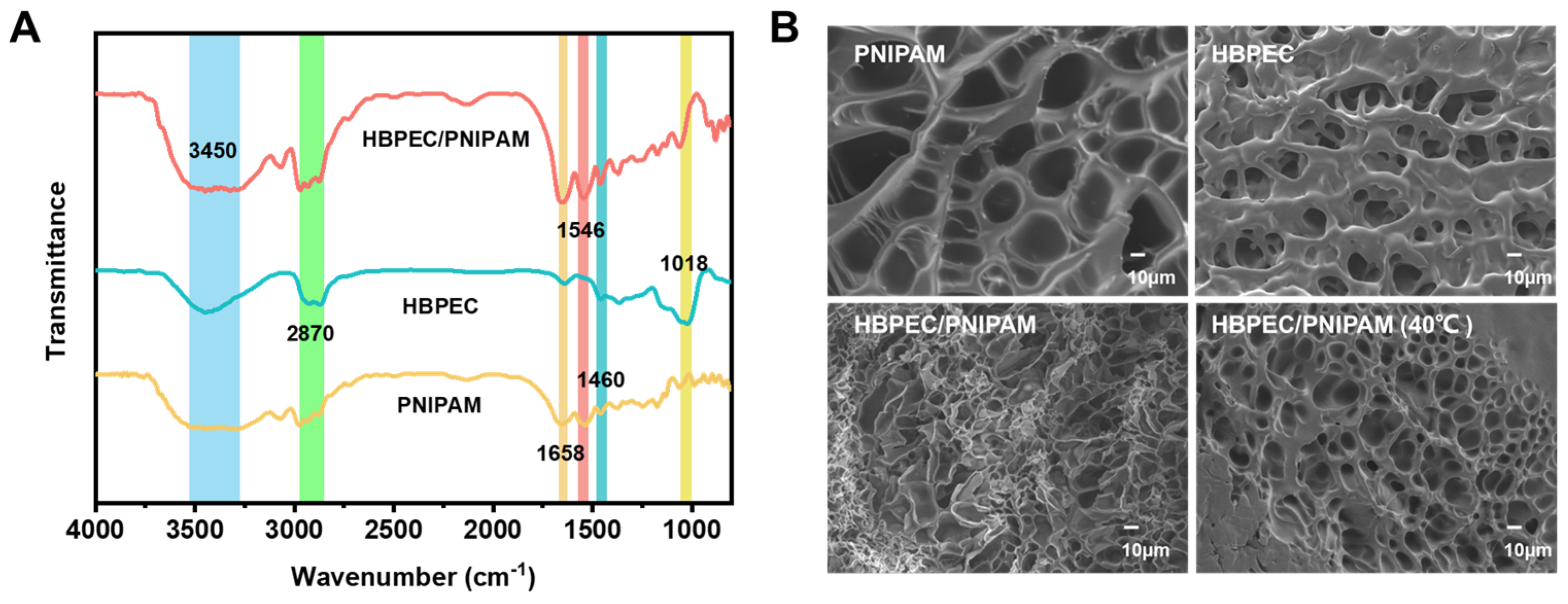
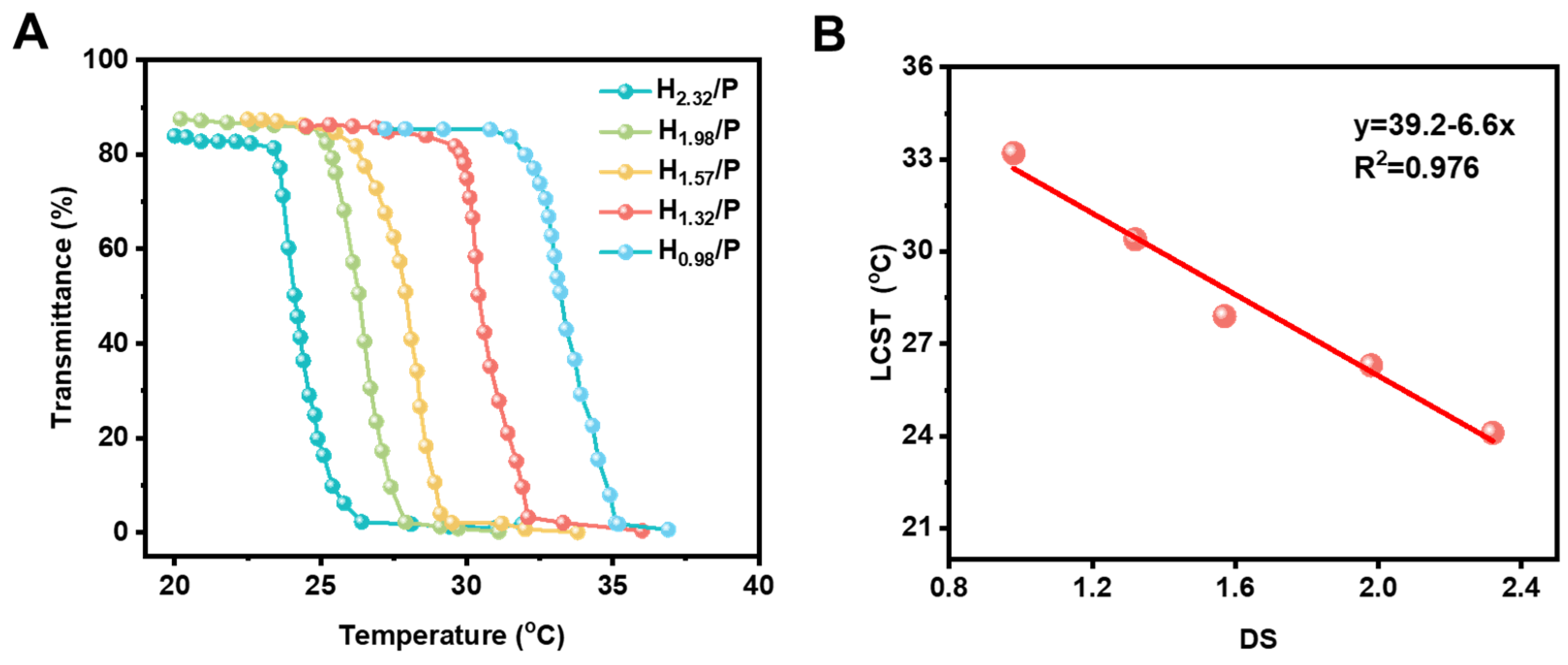
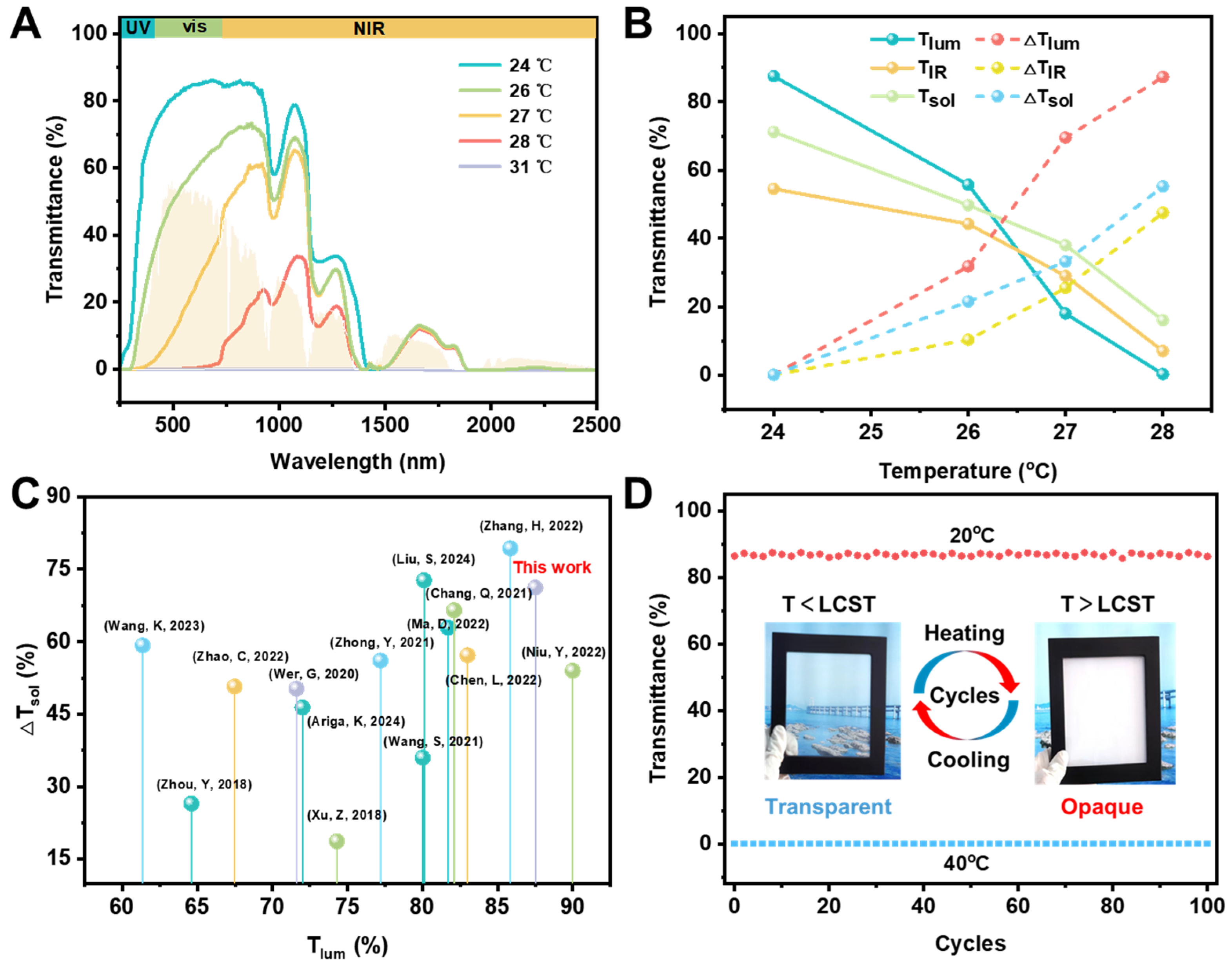
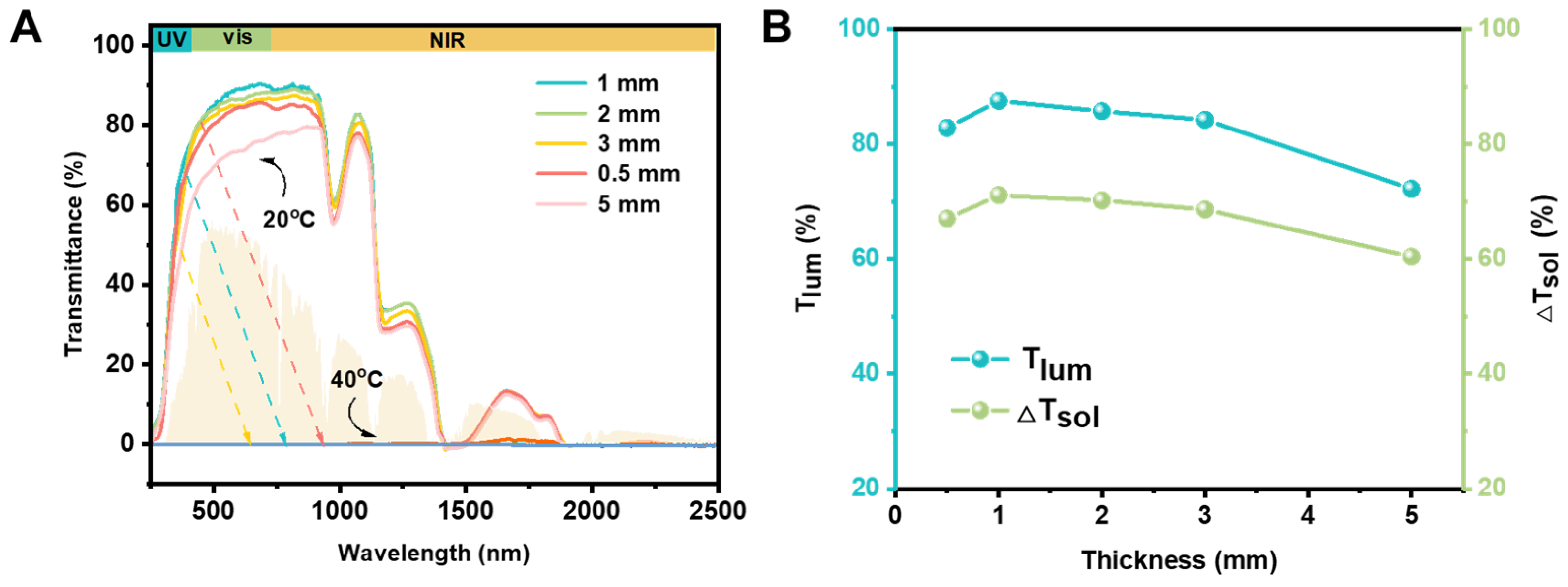

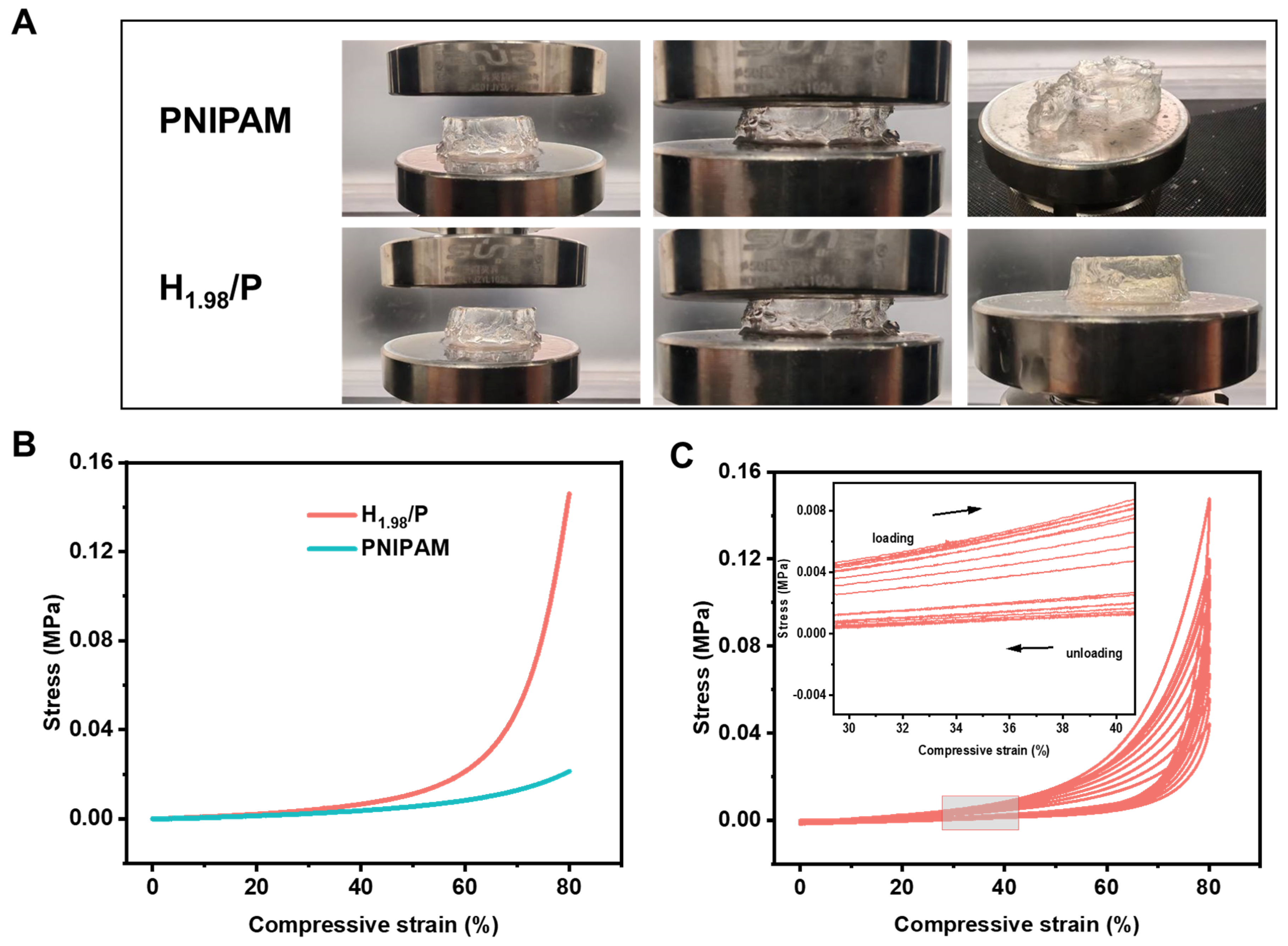
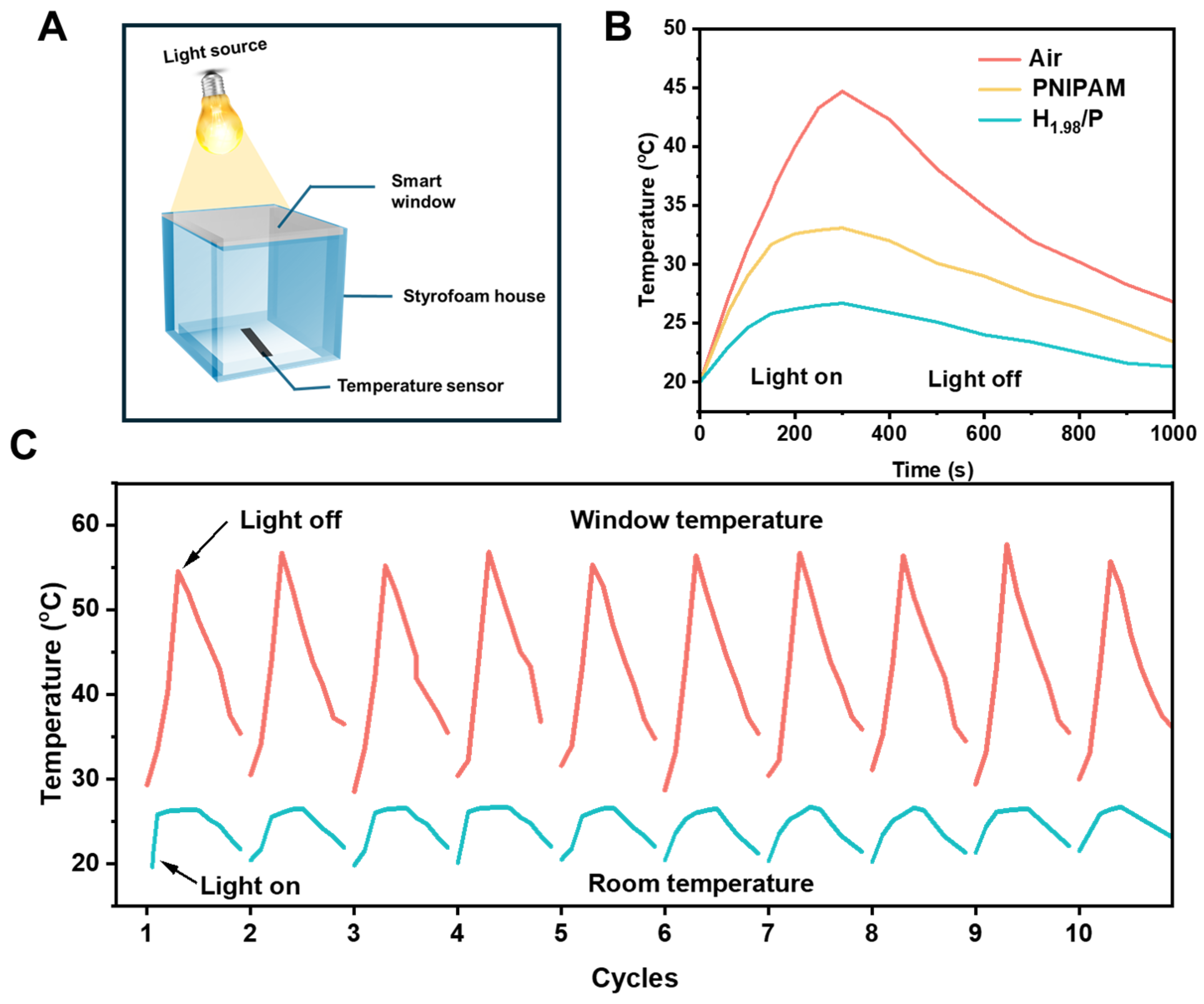
| Sample | DS | HBPEC (g) | NIPAM (g) | MBA (mg) | KPS (mg) | NaHSO3 (mg) | H2O (g) |
|---|---|---|---|---|---|---|---|
| PNIPAM | - | 0.2 | 0.9 | 5.44 | 5 | 3 | 7 |
| H0.98/P | 0.98 | 0.2 | 0.9 | 5.44 | 5 | 3 | 7 |
| H1.32/P | 1.32 | 0.2 | 0.9 | 5.44 | 5 | 3 | 7 |
| H1.57/P | 1.57 | 0.2 | 0.9 | 5.44 | 5 | 3 | 7 |
| H1.98/P | 1.98 | 0.2 | 0.9 | 5.44 | 5 | 3 | 7 |
| H2.32/P | 2.32 | 0.2 | 0.9 | 5.44 | 5 | 3 | 7 |
Disclaimer/Publisher’s Note: The statements, opinions and data contained in all publications are solely those of the individual author(s) and contributor(s) and not of MDPI and/or the editor(s). MDPI and/or the editor(s) disclaim responsibility for any injury to people or property resulting from any ideas, methods, instructions or products referred to in the content. |
© 2024 by the authors. Licensee MDPI, Basel, Switzerland. This article is an open access article distributed under the terms and conditions of the Creative Commons Attribution (CC BY) license (https://creativecommons.org/licenses/by/4.0/).
Share and Cite
Sun, M.; Sun, H.; Wei, R.; Li, W.; Lai, J.; Tian, Y.; Li, M. Energy-Efficient Smart Window Based on a Thermochromic Hydrogel with Adjustable Critical Response Temperature and High Solar Modulation Ability. Gels 2024, 10, 494. https://doi.org/10.3390/gels10080494
Sun M, Sun H, Wei R, Li W, Lai J, Tian Y, Li M. Energy-Efficient Smart Window Based on a Thermochromic Hydrogel with Adjustable Critical Response Temperature and High Solar Modulation Ability. Gels. 2024; 10(8):494. https://doi.org/10.3390/gels10080494
Chicago/Turabian StyleSun, Meng, Hui Sun, Ruoyu Wei, Wenqing Li, Jinlai Lai, Ye Tian, and Miao Li. 2024. "Energy-Efficient Smart Window Based on a Thermochromic Hydrogel with Adjustable Critical Response Temperature and High Solar Modulation Ability" Gels 10, no. 8: 494. https://doi.org/10.3390/gels10080494
APA StyleSun, M., Sun, H., Wei, R., Li, W., Lai, J., Tian, Y., & Li, M. (2024). Energy-Efficient Smart Window Based on a Thermochromic Hydrogel with Adjustable Critical Response Temperature and High Solar Modulation Ability. Gels, 10(8), 494. https://doi.org/10.3390/gels10080494






